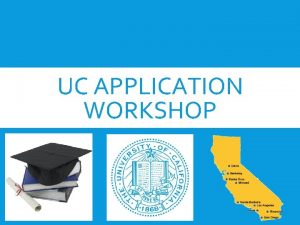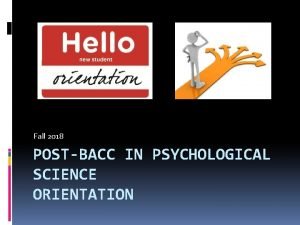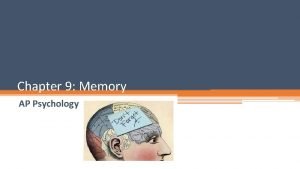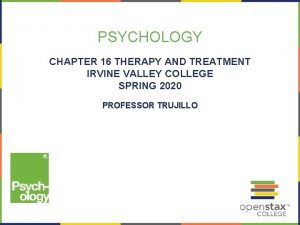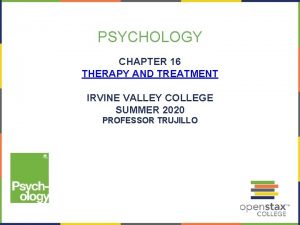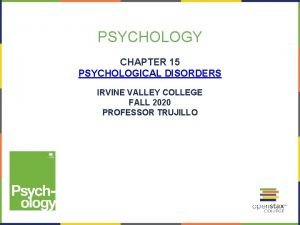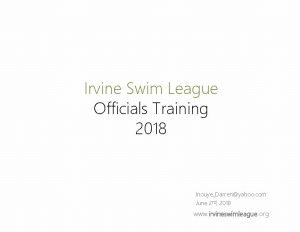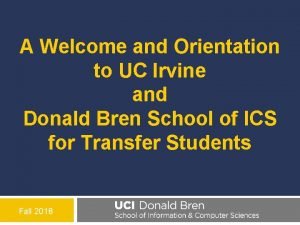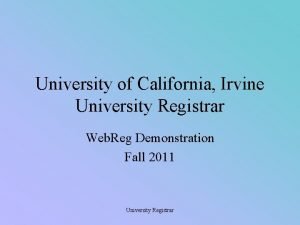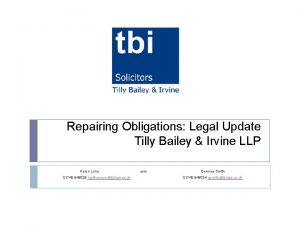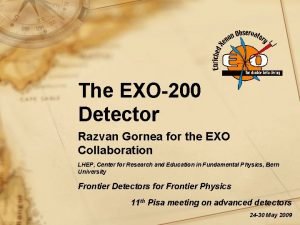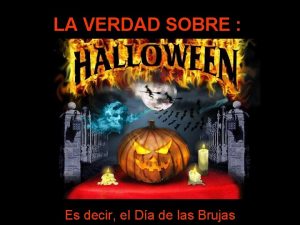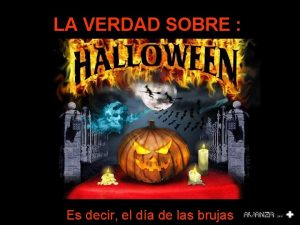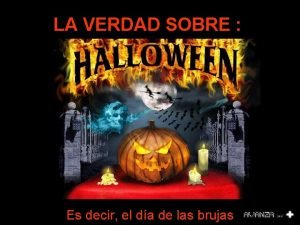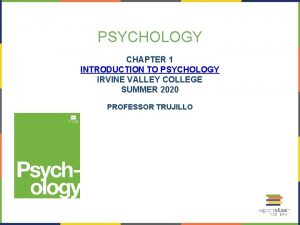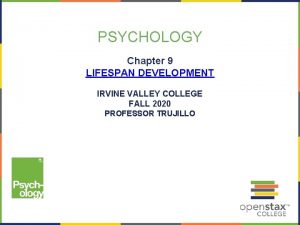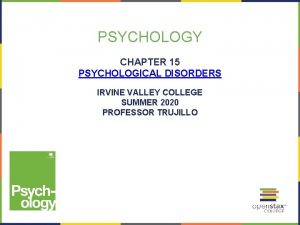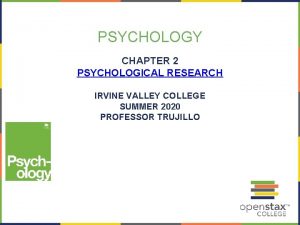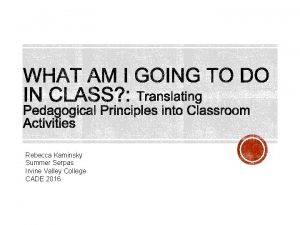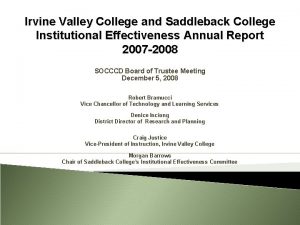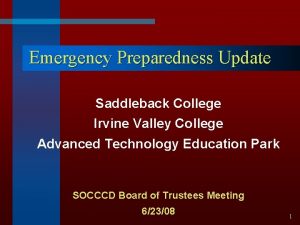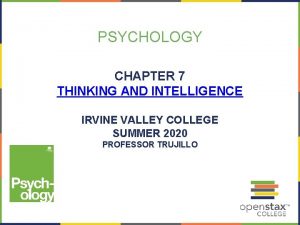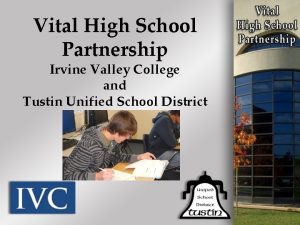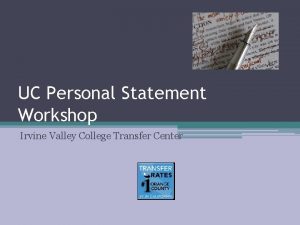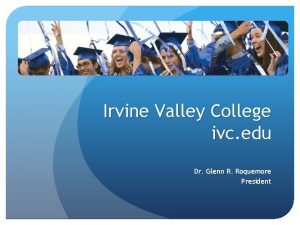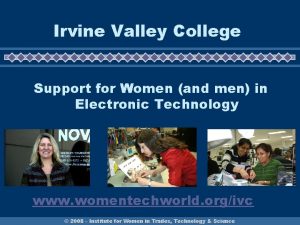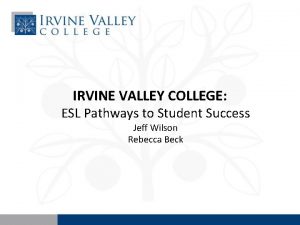PSYCHOLOGY CHAPTER 8 MEMORY IRVINE VALLEY COLLEGE SUMMER






















- Slides: 22

PSYCHOLOGY CHAPTER 8 MEMORY IRVINE VALLEY COLLEGE SUMMER 2020 PROFESSOR TRUJILLO

MEMORY Memory is the set of processes used to encode, store, and retrieve information over different periods of time. Encoding involves the input of information into the memory system. Storage is the retention of the encoded information. Retrieval is about getting the information out of memory and back into awareness, is the third function.

ENCODING Automatic Processing encoding of informational details like time, space, frequency, and the meaning of words. usually done without any conscious awareness Effortful Processing encoding of information that takes effort and attention

THREE TYPES OF ENCODING Semantic Encoding. input of words and their meaning (William Bousfield, 1935). Visual Encoding is the encoding of images. high-imagery words are easier to recall e. g. dog, car, book. low-imagery words more difficult to recall e. g. value, correlate, level. Acoustic Encoding is the encoding of sounds, words in particular. words, song, rhyme, rhythm.

STORAGE Human memory model first proposed by Richard Atkinson and Richard Shiffrin (1968) According to the Atkinson-Shiffrin model of memory, information passes through three distinct stages in order for it to be stored in longterm memory.

STORAGE Sensory memory: storage of brief sensory events, such as sights, sounds, and tastes. It is very brief storage—up to a couple of seconds. • Stroop Effect -you will name a color more easily if it appears printed in that color. Short-term Memory (STM) processes incoming sensory memory, takes information from sensory memory and sometimes connects that memory to something already in long-term memory, lasts about 20 seconds. • George Miller (1956) found people have the capacity to retain about 7 plus or minus 2 items in STM. • Rehearsal is key conscious repetition of information to be remembered to transfer to LTM

FIGURE 8. 5 The Stroop effect describes why it is difficult for us to name a color when the word and the color of the word are different.

FIGURE 8. 6 Work through this series of numbers using the recall exercise explained above to determine the longest string of digits that you can store.

STORAGE Long-term memory (LTM) is the continuous storage of information. LTM capacity is unlimited. • Explicit memory includes episodic and semantic memory. • Implicit memory includes procedural memory and things learned through conditioning.

RETRIEVAL Retrieval is the act of getting information out of longterm memory storage and back into conscious awareness • Recall is the access information without cues. For example, e. g. an essay test. • Recognition involves identifying information previously learned. It involves a process of comparison e. g. a multiple-choice test, . • Relearning involves learning information that you previously learned. ?

8. 2 MEMORY: PARTS OF THE BRAIN Karl Lashley had great contributions to the study of learning and memory. He searched for the Engram: the group of neurons that serve as the “physical representation of memory”, but he did not find it. Equipotentiality Hypothesis: if part of one area of the brain involved in memory is damaged, another part of the same area can take over that memory function (Lashley, 1950).

8. 2 MEMORY: PARTS OF THE BRAIN Parts of the Brain Implicated in Memory The Amygdala is involved in emotion regulation including fear, fear memory, and aggression. The Hippocampus is associated with declarative and episodic memory as well as recognition memory. The Cerebellum plays a role in processing procedural memories, such as how to play the piano. The Prefrontal Cortex appears to be involved in remembering semantic tasks. Watch Steve Ramirez and Xu Liu: A mouse. A laser beam. A manipulated memory. And the post talk.

AROUSAL THEORY Arousal Theory -strong emotions trigger the formation of strong memories, and weaker emotional experiences form weaker memories A Flashbulb Memory is an exceptionally clear recollection of an important event

FIGURE 8. 10 Most people can remember where they were when they first heard about the 9/11 terrorist attacks. This is an example of a flashbulb memory: a record of an atypical and unusual event that has very strong emotional associations. (credit: Michael Foran)

AMNESIA Amnesia is the loss of long-term memory that occurs as the result of disease, physical trauma, or psychological trauma. Retrograde Amnesia- Memory problems that extend back in time before the injury and prevent retrieval of information previously stored in long-term memory. The case of Scott Bolzan is an example of this type of amnesia. Anterograde Amnesia- Memory problems that extend forward in time from the point of injury and prevent the formation of new memories,

AMNESIA On September 1, 1953, time stopped for Henry Molaison (H. M. ) For roughly 10 years, the 27 -year-old had suffered severe seizures. By 1953, they were so debilitating he could no longer hold down his job. On September 1, the hippocampus was removed to hopefully quell the seizures wracking his brain. The seizures abated, but afterwards he was left with permanent amnesia. He could remember some things from his childhood, some historical events before his surgery. However, was unable to form new memories - Anterograde Amnesia and temporally graded Retrograde Amnesia.

MEMORY CONSTRUCTION AND RECONSTRUCTION Construction: formulation of new memories Reconstruction: process of bringing up old memories • Suggestibility describes the effects of misinformation from external sources that leads to the creation of false memories. • Eyewitness misidentification can lead to wrongful convictions. About 75% of people wrongfully convicted based on eyewitness misidentification have been exonerated by DNA. The Innocence Project discovered that eyewitness misidentification is the leading cause of wrongful convictions (Benjamin N. Cardozo School of Law, Yeshiva University, 2009).

Loftus and Palmer (1974) Misinformation Effect Paradigm: after exposure to incorrect information, a person may misremember the original event. When people are asked Leading Questions about an event, their memory of the event may be altered. Loftus and Palmer (1974) conducted a study where participants watched a video of an accident. The IV was the verb of action and the DV was the perceived speed of cars. (credit a: modification of work by Rob Young)

Loftus and Palmer (1974) In the condition containing a leading question using the verb of action “smashed”, participants estimated the speed of the cars higher than the others conditions with verbs of action: “collided” “bumped” “hit” and “contacted” (credit a: modification of work by Rob Young)

PROACTIVE VS RETROACTIVE INTERFERENCE Sometimes forgetting is caused by a failure to retrieve information. Proactive Interference: old information hinders the recall of newly learned information Retroactive Interference: information learned more recently hinders the recall of older information

8. 3 WAYS TO ENHANCE MEMORY Rehearsal: conscious repetition of information to be remembered. Chunking: organizing information into manageable bits or chunks e. g. FBICIA Mnemonic devices are memory aids that help us organize information for encoding e. g. Mr. VEM J. SUN This is a knuckle mnemonic to help you remember the number of days in each month. Months with 31 days are represented by the protruding knuckles and shorter months fall in the spots between knuckles. (credit: modification of work by Cory Zanker)

HOW TO STUDY EFFECTIVELY • Use elaborative rehearsal • Apply the self-reference effect • Don’t forget the forgetting curve • Rehearse, rehearse • Be aware of interference • Keep moving • Get enough sleep • Make use of mnemonic devices
 Transfer center ivc
Transfer center ivc Irvine valley memories
Irvine valley memories Irvine valley water district
Irvine valley water district Evergreen valley college calendar
Evergreen valley college calendar Uci post bacc
Uci post bacc Chunking psychology definition
Chunking psychology definition Memory stages model
Memory stages model Crescenta valley high school graduation 2021
Crescenta valley high school graduation 2021 Altruism definition psychology
Altruism definition psychology Garcia effect
Garcia effect Exposure therapy irvine
Exposure therapy irvine Body dysmorphia irvine
Body dysmorphia irvine Irvine swim league
Irvine swim league Irvine water district
Irvine water district Uci prerequisite clearing
Uci prerequisite clearing Uci registrar
Uci registrar Tilly bailey & irvine llp
Tilly bailey & irvine llp Irvine ranch water district
Irvine ranch water district Irvine animal care center
Irvine animal care center Liquid xenon
Liquid xenon Quien es doreen irvine
Quien es doreen irvine Quien fue doreen irvine
Quien fue doreen irvine Quien es doreen irving
Quien es doreen irving
